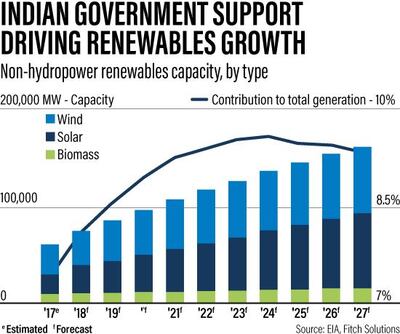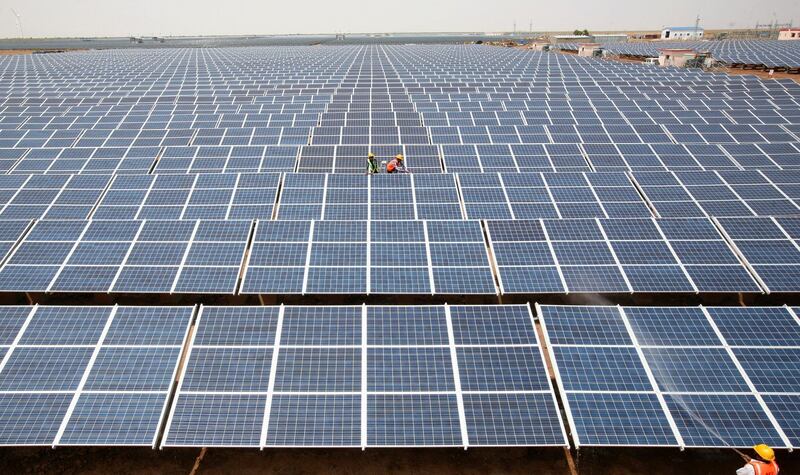Sharath Devineni, a young engineer from Bangalore, decided to risk it all a couple of years ago and set up a company to help households and small businesses switch to solar power for their energy needs.
With a rapidly growing appetite for energy in India, coupled with the expense of oil and coal imports and depleting fossil fuel reserves, Mr Devineni, the co-founder of Solarify, firmly believes renewable energy can address the country's challenges ahead.
“It's kind of a no-brainer given the economic benefits and the environmental factors,” he says.
The Indian government has ambitious targets to expand its renewables sector. By 2030, it wants the country, which is Asia's third-largest economy, to generate 40 per cent of its energy from renewable sources. India is aiming to generate 175 gigawatts from renewable energy sources by 2022. Solar power accounts for the majority of that mix with a target of 100GW, followed by wind power as the next largest source.

“It won’t be an exaggeration to say that India is running the most ambitious and largest renewable capacity expansion programmes in the world,” says Shiva Vig, the chief executive of Biod Energy, a bio diesel producer based in Haryana in north India. “We're a fast-growing economy and our need for energy is constantly on the increase. Long-term solutions can only come from renewable energy.”
But there is much scepticism around whether India is really likely to meet its goals.
“Our capacity forecasts ... do fall below government targets,” according to a report by Fitch Solutions Macro Research, part of ratings agency and financial information firm Fitch Group.
It cites the challenges around executing renewables projects in India and proposed duties on solar power imports, which mainly come in from China and Malaysia, as being among the major risks to the industry's growth.
It forecasts that India is only likely to manage to generate 120GW from renewables by 2022, more than 30 per cent below the government's targets. India's renewables capacity will double over the coming decade to total more than 163GW by 2027, according to Fitch.
“Project realisation risks, stemming from bureaucratic, financing and logistical delays continue to plague the Indian infrastructure sector as a whole and the country’s underdeveloped and inefficient grid system threatens the power generated from renewables projects,” the report states.
Nevertheless, despite the fact that India is likely to miss its targets, it remains “global renewable energy investment bright spot”, with investment reaching close to $20 billion last year – more than the investment into India’s thermal power sector, according to Fitch.
_______________
Read more:
[ World's biggest offshore wind farm unveiled in UK's Irish Sea ]
UAE backs breakthrough in offshore wind energy tech
Shell and partners said to want to sell windfarm stakes
_______________
There are plenty of factors, including energy security, which mean renewables are vital for the country, helping to fuel investor interest.
The vast majority of India’s energy needs today are met by coal-fuelled power plants. But there are still about 300 million people in the country who do not have access to electricity, according to the World Bank.
India's energy demands are only rising. The economy is expanding, growing at 8.2 per cent in the April to June quarter, boosted by the power-hungry manufacturing sector and urbanisation is the trend in a population of more than 1.3 billion people.
Meanwhile, there is significant pressure on India – which is the third-largest carbon emitter after the United States and China - to reduce its carbon footprint, making it imperative for the country to step up its adoption of green energy.
Under the Paris global climate agreement, India has committed to generate at least 40 per cent of the country’s electricity from non-fossil sources in an effort to tackle climate change. Thirteen of the world’s 20 most polluted cities are in India, according to the World Health Organisation.
India is one of the three worst offending countries when it comes to the environment, dropping 46 notches from 2016 to rank 177 out of 180 countries in the environmental performance index released by the World Economic Forum in January.
“India’s transition to sustainable energy sources is inevitable,” says Vineet Mittal, the chairman of Avaada Group, a Mumbai-based producer of renewable energy, which has solar and wind projects across India.
“Although there are critical challenges the sector is currently facing, it is imperative that the country moves speedily to combat issues like climate change, energy security and widespread development of the country’s sizeable population. For instance, recent floods in Kerala and other states are a direct consequence of climate change.”
But Mr Mittal says that when it comes to solar energy, “the current policies being adopted by the government are not conducive to the sector’s growth”.
He cites the government in July imposing so-called safeguard duties on solar imports an example of unfavourable policies, adding to the costs of green energy. Such a measure is designed to protect solar manufacturers in India but the country is not currently producing enough solar equipment to support the planned expansion, meaning that companies are heavily reliant on imports of panels.
Rahul Walawalkar, the executive director of India Energy Storage Alliance, based in Pune, also says that the sector is not expanding as fast as it could, given the enormous potential.
“We have lost significant time in just discussing these issues,” he says, pointing out that India's energy ministries have set up various committees aimed at advancing the renewables and energy storage sector, but he says these have not actually translated to substantial action on the ground.
“Over past three to four years, industry has enthusiastically supported all these efforts and have submitted detailed proposals to government,” says Mr Walawalkar. “Unfortunately, they haven't resulted in actual commissioning of projects. This had created a huge concern for the industry both in India and globally.”
It is not proving to be be an easy journey for Mr Devineni and his company, although he says that awareness is slowly increasing in India when it comes to clean energy.
The initial costs of changing to solar energy is one of the major obstacles, he says.
“It becomes a challenge for business because they don't want to put the money they might need to grow their business into solar,” he says.
Most of Solarify's customers have in fact been individuals who want to install solar energy in their homes.
It would cost a typical middle-class Indian household in Bangalore 200,000 rupees (Dh10,188) to convert to solar energy.
Bur he says that the economic benefits are huge, once that initial investment is made, because the power generated once a solar energy system installed is essentially free.
The weather conditions are also ideal for India, with much of the country exposed to large amounts of sunshine.
Mr Vig at Biod Energy explains that the development of the biofuels segment is also facing obstacles, despite the fact that there is a biofuel policy in place designed to boost the green fuel to reduce India's dependence on crude, which has become more expensive to import because of higher oil prices globally and the rupee's tumble to a record low against the US dollar.
“To talk specifically about biofuel and its benefits, the concept is low on awareness,” he says. “Our country lacks adequate infrastructure to harness its potential.”
Nevertheless, he points out that there very promising signs of progress for India's renewables industry, such as the fact that the country is home to the world's first airport to run completely on solar power, located in Kochi in Kerala, while earlier this year, Guwahati in Assam became home to India's first railway station to run on solar power.
Overall, the sector generally remains hopeful that there is bright future ahead for renewable energy sources in India.






